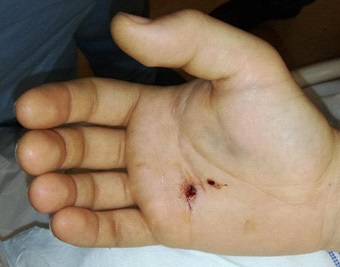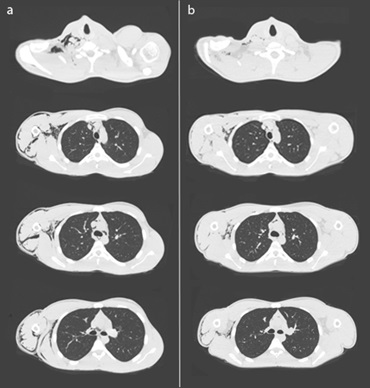
Journal of Clinical Images and Medical Case Reports
ISSN 2766-7820
Clinical Image - Open Access, Volume 3
Subcutaneous and visceral emphysema due to industrial air gun injury
Castiello Emanuela*; Luca Amendola; Camilla Pungetti; D Tigani
Orthopaedic and Traumatology Department, Azienda USL Bellaria-Maggiore, Bologna, Italy.
*Corresponding Author: Castiello Emanuela
Orthopaedic and Traumatology Department, Azienda USL Bellaria-Maggiore, Bologna, Italy.
Email: emanuela.castiello@ausl.bologna.it
Received : Jan 05, 2022
Accepted : Feb 08, 2022
Published : Feb 15, 2022
Archived : www.jcimcr.org
Copyright : © Emanuela C (2022).
Citation: Emanuela C, Amendola L, Pungetti C, Tigani D. Subcutaneous and visceral emphysema due to industrial air gun injury. J Clin Images Med Case Rep. 2022; 3(2): 1661.
Description
A 21-year-old man presented to our emergency department suffering for right arm tightness and stiffness with mild pain following a high-pressure air working injury. On examination, the right hand palm showed a small gunshot wound (Figure 1), a swelling and crepitus was palpable from the tips of the fingers through to the whole upper limb extending up to the lateral right cervical region. No neurological impairments or fever were recorded. His vital signs were stable and laboratory tests were within a normal range (WBC 8.39 109/L mmc, CRP 0.10 mg/dL, fibrinogen 245 mg/dL). The wound was irrigated, cleaned and sterile dressing was applied. The right hand x-ray resulted negative for acute fracture.
Urgent CT scan of the upper limb and neck revealed an extensive subcutaneous and subfascial emphysema from the right hand through to the cervicofacial tissues of the laterocervical neck associated with pneumomediastinum (Figure 2a). Thorachic surgeon on-call confirmed no surgical indication. Due to non-sterile circuit of the industrial air-gun, prophylactic antibiotics (Amoxicillin/clavulanic acid 2,2 gr/6h IV) were administrered immediately and continued until discharge preventing the potential infection by gas-forming bacteria. Considering patient’s stable vital signs monitored during the hospitalization, the authors continued with conservative treatment. No splint was placed but rest of the limb was recommended. Five days after injury, the patient was discharged with mild residual emphysema on CT scan (Figure 2b) and laboratory test negative for infection. At two months follow-up, there was complete clinical resolution of the emphysema and all symptoms were regretted. Subcutaneous emphysema of the whole upper limb and the neck is a rare event. It is crucial to recognize infectious forms in order to perform a promptly surgical debridement and fasciotomy [1]. Conservative management is indicated for non-infective cases, which presented with no signs of sepsis [2].
Our case was potentially at risk of infectious from gas-forming organisms due to the huge presence of non-sterile gas in the soft tissues after trauma. Nevertheless, no clinical evidence of infection was observed during hospitalization. However, a watch-and-wait policy is suggested for 24-48 hours [3] associated with an immediately antibiotic therapy and the rest of the limb without sling, although it is not suggested by Crampton in his report [4]. Furthermore, a careful examination and close observation of the patient is mandatory in such cases to avoid unnecessary surgical treatment in patients with stable vital signs.
References
- Constantine T, Musharrafieh U, Rammal A, Moukaiber S, Haider R. Non-infectious subcutaneous emphysema of the hand: a case report and review of the literature. Emerg Med J. 2010; 27(5): 383-6.
- Eyres KS, Morley T. Subcutaneous emphysema of the upper limb: an air-gun injury. J Hand Surg Br. 1999; 18(2): 251-3.
- Tiong WHC, Butt FS. Subcutaneous emphysema of the upper extremity following penetrating blackthorn injury to the wrist. J Plast Reconstr Aesthet Surg, 2009; 62 (2): e29-32.
- Crampton JA. An unusual case of surgical emphy.


